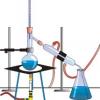|
|

Condensate Stabilisation - Operating A Stabilizer/reboiler Wet (With W
Started by Olaniyi, Sep 12 2012 01:26 AM
3 replies to this topic
Share this topic:
#1

Posted 12 September 2012 - 01:26 AM
Hi all
I asked a variant of this question a while back but got no responses, so I'm trying to ask a more specific question.
(1) Has anyone ever worked with a condensate stablisation unit where the feed was deliberately kept water "wet" to prevent salt precipitation.
(2) In such a case, what kind of reboiler did you have? How does the reboiler perform with water in it? Any special considerations?
Thanks
Ogeds
I asked a variant of this question a while back but got no responses, so I'm trying to ask a more specific question.
(1) Has anyone ever worked with a condensate stablisation unit where the feed was deliberately kept water "wet" to prevent salt precipitation.
(2) In such a case, what kind of reboiler did you have? How does the reboiler perform with water in it? Any special considerations?
Thanks
Ogeds
#2

Posted 12 September 2012 - 02:27 AM
If water is present in the feed, we always remove it before feeding to the stabilizer preferably using a liquid/liquid coalecser system. The system portraited by you does not make sense. If you are deliberately sending a "wet" feed to a stabilizer, get ready for following problems:
Regards,
Haseeb Ali
- Much of the Water will evaporate in the stabilizer leaving the salt behind
- Deposits in the column and the reboiler
- Increase in energy consumption
- A water/condensate emulsion stabilized by salts will be formed which will be difficult to break
- Difficulties in operating the stabilizer
- Frequent shutdowns & cleaning requirements
- Product quality will suffer. Who will buy your salt rich condensate?
- Water deposits in condensate storage tank
- Corrosion in condensate export lines
- Solids accumulation inside the pipelines
Regards,
Haseeb Ali
Edited by P.Engr, 12 September 2012 - 03:08 AM.
#3

Posted 13 September 2012 - 07:08 AM
Hi Haseeb
Thanks for your comments. However I do not fully agree with them. Maybe I should mention that I have about 99% soluble salts (in water) from the formation analysis. I've responded to the issues you raised below:
Thanks for your comments. However I do not fully agree with them. Maybe I should mention that I have about 99% soluble salts (in water) from the formation analysis. I've responded to the issues you raised below:
If water is present in the feed, we always remove it before feeding to the stabilizer preferably using a liquid/liquid coalecser system. The system portraited by you does not make sense. If you are deliberately sending a "wet" feed to a stabilizer, get ready for following problems:
- Much of the Water will evaporate in the stabilizer leaving the salt behind . Not necessarily. Only a certain amount of water can evaporate before you attain equilibrium in the column based on the partial pressure of water. The target is for the additional water to be sufficient to keep the salt in solution and prevent precipitation of crystals.
- Deposits in the column and the reboiler. See above
- Increase in energy consumption. Disagree.. the water will provide a more efficient stripping and you should actually be able to operate the column at a lower tempereture. In fact this lower operating temperature is one of the main advantages of operating the column wet, especially if close to 100% water removal cannot be guaranteed either upstream of with a side draw.
- A water/condensate emulsion stabilized by salts will be formed which will be difficult to break. A small amount of water will dissolve in the condensate. This is not a problem as long as specs are met or separation facilities (settling tank for example) are persent downsteream. Salt (in solution) will remain in the free water, and not in the water dissolved in the condensate.
- Difficulties in operating the stabilizer . This is what I am trying to predict. For the trays themselves I dont expect significant difficulties - I know at least three sites operating partially wet columns for this purpose (side draw used to remove water to ensure dry operation in the bottom part of the column). However I am not sure exactly what will happen in a wet reboiler.
- Frequent shutdowns & cleaning requirements . Not necessarily, see above (as long as you keep salts from precipitating out. Reboiler again is the potential "black box" in terms of what may happen. You should be able to avoid scaling by staying below a certain temperature.
- Product quality will suffer. Who will buy your salt rich condensate? Typical salt spec is 25 pptb or so. You can achieve this with an electrostatic desalter upstream of the stabilizer. But you still have to deal with the salt that does make it into the plant.
- Water deposits in condensate storage tank. There will almost always be water separating out in a condensate storage tank. Dewatering facilities are typical.
- Corrosion in condensate export lines. Ok
- Solids accumulation inside the pipelines Again this is based on the assumption that the salts precipitate out, which should not happen as long as you are able to maintaine a certain minimum amount of water.
Regards,
Haseeb Ali
#4

Posted 13 September 2012 - 01:32 PM
Ogeds,
Your original query was about reboiler type. Anything except a kettle whould be fine. You want to make sure that the water circulates through the reboiler, too.
Bobby
Your original query was about reboiler type. Anything except a kettle whould be fine. You want to make sure that the water circulates through the reboiler, too.
Bobby
Similar Topics
Condensate CirculationStarted by Guest_Anastasia1905_* , 30 Sep 2025 |
|

|
||
Distillation Column Reboiler QuestionsStarted by Guest_AlanC079_* , 07 Jul 2025 |
|

|
||
Levels For Kettle Type ReboilerStarted by Guest_RajD_* , 04 Apr 2025 |
|

|
||
How To Remove The Condensate In A Wet Gas StreamStarted by Guest_ksagarzazu_* , 25 Feb 2025 |
|

|
||
Phe As ReboilerStarted by Guest_Chemeng40_* , 20 Feb 2025 |
|

|

 FB
FB







